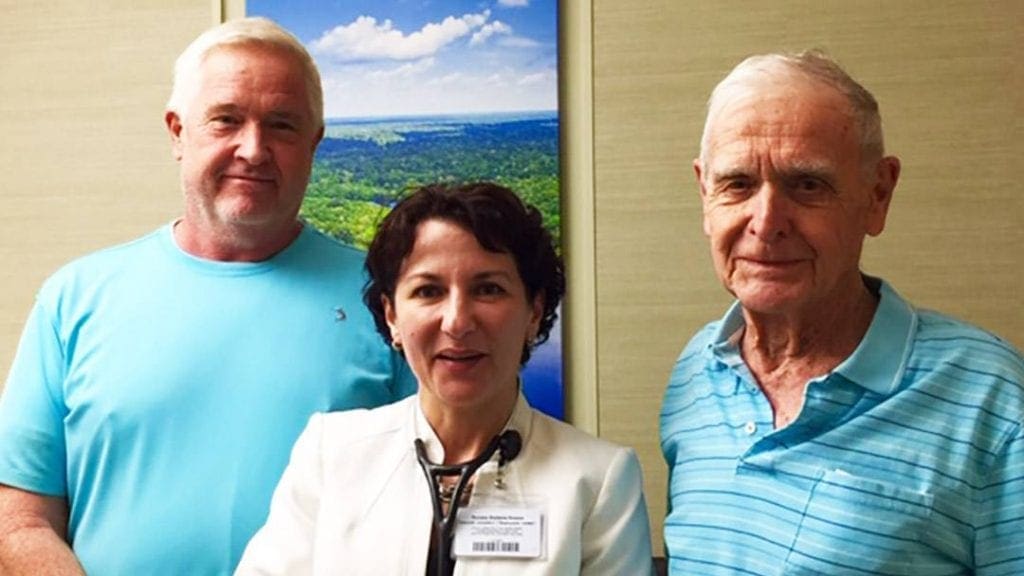Beating Melanoma is a Family Affair for the Devans

When Doug and Byron Devan were diagnosed with melanoma, the son and father turned to Mayo Clinic to help them fight the disease. Their physician recommended innovative immunotherapy treatment, and now both men are in remission.
Even before he had his own experience receiving care at Mayo Clinic, Doug Devan of Orange City, Florida, had always associated the health care organization with hope.
“Growing
up in Illinois, we had a family friend who had an illness for years, and the
local doctors couldn’t pin it down,” Doug says. “She went to Mayo
Clinic, and they fixed it in three days. I’ve heard quite a few stories like
that about Mayo over the years.”
Now
Doug, who is a commercial airline pilot, and his father, Byron, who is a
retired U.S. Air Force pilot, have Mayo Clinic stories of their own to share.
Over
the years, the two suspected that they might be at increased risk for skin
cancers because of the extended time they spent as pilots flying at high
altitudes with increased exposure to ultraviolet rays. But only recently did
that risk become a reality — for both of them.
New tools in the toolbox
Doug’s diagnosis of melanoma, the deadliest form of skin cancer, came first. But after he took some time to digest the news, he didn’t question his chances of survival. Instead, he took steps to ensure he had the best odds possible. “When you hear that diagnosis — stage 3 melanoma — it makes you sit down and take a big gulp of air,” Doug says. “But I’m a positive person, and they have new tools in the toolbox to fix this.”
But as Doug traveled to medical centers across Florida, he didn’t hear much about immunotherapy, and other new or nonsurgical techniques for treating his melanoma. He had one surgery to remove a small mass from his neck, but the tumors returned. The next step, he was told, was a surgical technique called a total neck dissection, followed by radiation therapy.
Doug
worried the treatment might affect his career as a pilot. “With surgery,
there’s a risk of nerve damage. I was concerned that it might restrict the
mobility in my neck and interfere with my ability to interact with the public,
which is part of our job as pilots,” Doug says. “I thought we could
try something else first, and the surgery could always be an option if our
first choice didn’t work.”
“About 45% to 50% of melanoma patients respond to these therapies. … They work especially well for patients like Doug, whose disease burden was not too high when he came to us for treatment.”
Roxana Dronca, M.D.
Looking for alternatives, in spring 2018, Doug called Mayo Clinic‘s Florida campus. Three days later, he had an appointment with Roxana Dronca, M.D., a medical oncologist and immunotherapy expert who has performed pioneering research on the treatment of melanoma. Dr. Dronca was impressed with Doug’s proactive approach to his condition. And his hopes for his medical treatment were consistent with her own experiences as a physician and researcher.
“Melanoma
has become a sort of poster child for the effectiveness of checkpoint
inhibitors, which are immunotherapy drugs that block a tumor cell’s ability to
hide from our immune system,” Dr. Dronca says. “About 45% to 50% of
melanoma patients respond to these therapies. Research here at Mayo Clinic and
other centers show they work especially well for patients like Doug, whose
disease burden was not too high when he came to us for treatment.”
But even Dr. Dronca was surprised by Doug’s response to the treatment. He experienced no side effects, and after the first round of infusions, Doug noticed he could no longer feel swelling in the lymph nodes in his neck. An ultrasound confirmed how well the therapy had worked. It showed no evidence of detectable cancer.
“I
was so happy when I saw his scan results,” Dr. Dronca says. “We can
keep Doug on this treatment indefinitely, but our current plan is to continue
it for two years. Based on the literature and what we know from our research,
he has a 95% chance of staying in complete remission for years after completing
immunotherapy.”
Like son, like father
About the same time that Doug received the good news about his treatment, Byron learned he would be starting his own journey through melanoma. For years, Byron had been under the care of an oncologist near his home in in Edgewater, Florida, to monitor a nodule in his lung. A scan showed that the nodule had grown and spread to other parts of his lung. Biopsy results indicated that the nodule was melanoma.
As
soon as he heard the news, Byron called Doug, who was at Mayo Clinic. Doug
shared the news and biopsy results with Dr. Dronca, and she told them to make
an appointment for Byron as soon as possible. After some additional testing,
Dr. Dronca confirmed Byron had metastatic melanoma that had spread from his
lung to his liver and lymph nodes. She also learned that his tumor type had a
genetic mutation, called BRAF. That information gave them an additional
treatment option because there is a cancer therapy that specifically targets
this mutation. But Dr. Dronca decided to keep that as a second option.
“We
have some evidence that targeted therapies can in the long run increase a
cancer’s resistance to therapies, and those therapies can have more significant
side effects, which is a concern for elderly patients,” Dr. Dronca says. “So
I believed he was a good candidate for the same treatment that Doug received,
and we could always try a targeted therapy after that.”
The value of listening
Byron
received his first infusion on Dec. 26, 2018, and now he is in complete
remission. Although Byron experienced side effects — including atrial
fibrillation, which Mayo Clinic cardiologists are managing in collaboration
with Dr. Dronca — he doesn’t require any cancer treatment at this time. For
now, he is focused on exercising and getting stronger.
“I’m
not a fatalist,” Byron says. “I figured Doug had successful
treatment, and I can do the same thing. I’m looking forward to doing some
traveling and being cancer-free in five years.”
Dr.
Dronca says Byron’s response to the therapy is perhaps even more surprising
than Doug’s, but there is evidence to support the result he’s experiencing. “We
used to think our immune system ages, and it’s harder to reactivate as we grow
older,” she says. “But it seems our immune system is better trained
because we have seen so many antigens and foreign things throughout life. My
oldest patient is 98, and she has responded very well. So, clearly, age has
nothing to do with it.”
“I’m so thrilled with their results, and they really keep me going to do more research and get results like theirs for more patients.”
Roxana Dronca, M.D.
Both
Doug and Byron describe Dr. Dronca as the consummate physician. But she
describes herself simply as “a Mayo Clinic physician.” And to her,
that’s measured by more than just outcomes.
“To
me, Doug and Byron are about our primary value: putting the needs of the
patient first,” Dr. Dronca says. “We are trained to spend time with our
patients, talk to them and listen to what their goals are. If you cure someone’s
cancer, and they aren’t able to go on with life the way they want to, the cure
loses a lot of its meaning. I’m so thrilled with their results, and they really
keep me going to do more research and get results like theirs for more
patients.”
HELPFUL LINKS
- Learn more about melanoma.
- Read about the Cancer Immunology and Immunotherapy Program at Mayo Clinic.
- Connect with others talking about cancer on Mayo Clinic Connect.
- Explore Mayo Clinic’s Florida campus.
- Request an appointment.
